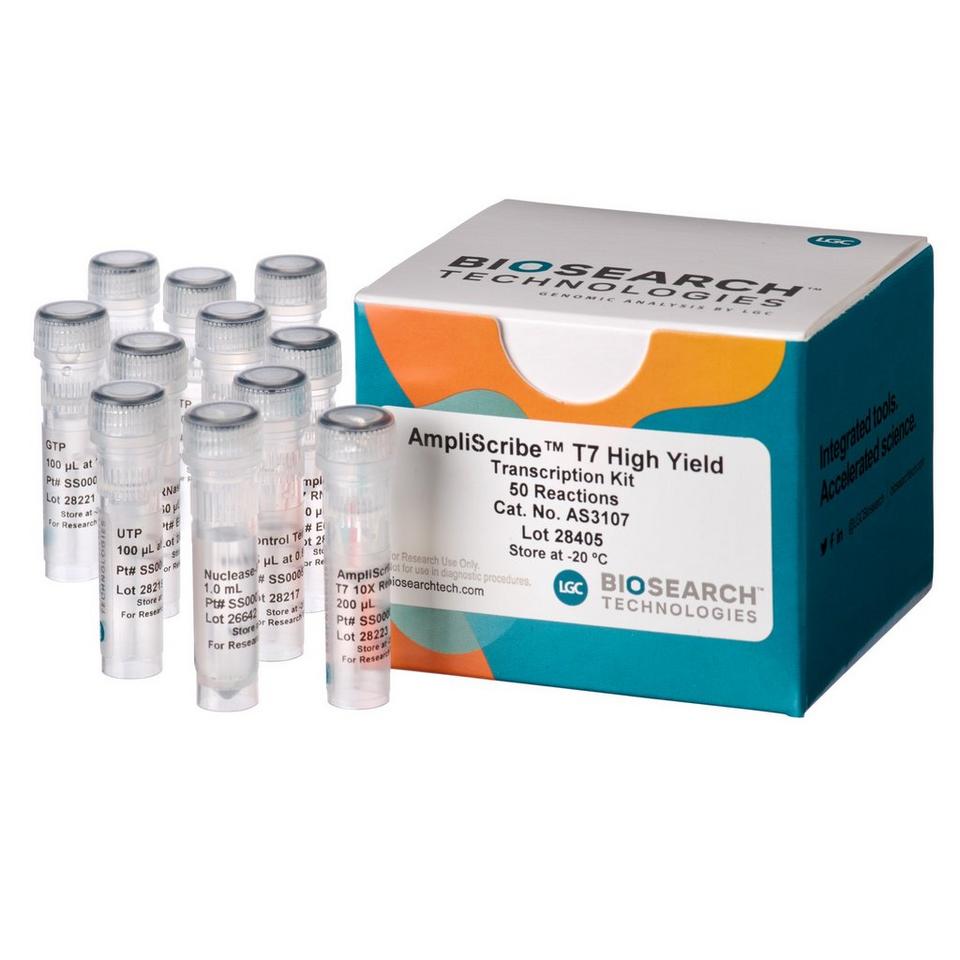Applications
- High-yield synthesis of RNA from DNA cloned downstream from a T7 RNA polymerase promoter, for microinjection, RNA interference, or antisense experiments.
- Structural and functional studies of splicing, processing, heterogeneous nuclear RNAs, tRNAs, viral RNAs, and ribozymes.1
- Production of fluorescent2-, biotinylated3-, or digoxigenin4- labeled RNA.
The AmpliScribe™ T7 High Yield Transcription Kit is specially formulated to use high concentrations of NTPs, that can be inhibitory to other in vitro transcription systems. AmpliScribe High Yield Transcription reactions can produce >20-fold more full-length RNA transcript than conventional in vitro transcription reactions. For example, the AmpliScribe T7 Kit yields approximately 5-7.5 mg/ml of 1.4-kb full-length control RNA in 30-120 minutes, respectively, using 1 µg of template DNA (Fig. 1)

Features
- High yield. Produce microgram amounts of RNA from all templates—synthesize both long (Fig. 2) and short RNA using only one kit.5
- Sensitive. Produce microgram amounts of RNA from as little as 1 ng of template.
- Scaleable. Increase the reaction size to produce milligram amounts of RNA.
- Flexible. Substitute a labelled nucleotide for one of the supplied NTP solutions.
- Convenient. Rnase inhibitor included.
Note: Because of the very high concentration of NTPs used in AmpliScribe reactions, these kits are not recommended for preparing high specific-activity radiolabeled RNA probes.
| |
 |
 |
| Figure 1. The AmpliScribe™ T7 High Yield Transcription Kit is specially formulated to consistently produce >20-fold more RNA than a conventional T7 in vitro transcription reaction |
Figure 2. An AmpliScribe™ T7 High Yield Transcription reaction produces full-length, long RNA transcripts. Aliquots from standard 20-µl AmpliScribe T7 High Yield Transcription reactions were loaded onto a denaturing 1% agarose-formaldehyde gel6 and stained with ethidium bromide. The size of the RNA transcripts and RNA yields (in parentheses) were: Lane 1, 3.0 kb (185 µg); lane 2, 4.0 kb (178 µg); lane 3, 5.0 kb (176 µg); lane 4, 6.0 kb (169 µg); lane M, RNA size marker. |
|
| |
|
References
- Johnson, M. (1995) Epicentre Forum 2(5), 4.
- DeLong, E.F. et al. (1999) App. And Environ. Microbiol. 65, 5554.
- Kaplan, E. et al. (1996) Epicentre Forum 3(2), 1.
- Hoff man, L.M. and Johnson, M.G. (1994) BioTechniques 17, 372.
- Schanke, J. (2000) Epicentre Forum 7(2), 6.
- Molecular Cloning - A Laboratory Manual, Third Edition, 2001. CSHL Press. pp 7.27 - 7.34. J. Sambrook and D. Russell.
If you cannot find the answer to your problem then please contact us or telephone +44 (0)1954 210 200